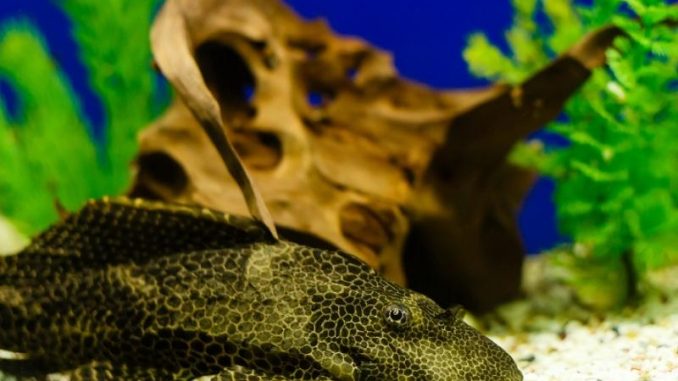
The sailfin pleco is a freshwater fish of the catfish family. The fish are similar to but slightly larger than, other popular pleco species, like the common pleco and the bristlenose pleco.
Sailfin plecos are large fish that have earned the nickname “leopard plecos” due to their leopard-like colors and markings.
This bottom-dwelling fish species are most active at night and have a peaceful temperament.
Sailfin plecos are popular among aquarists due to their unique appearance and ease of care, despite their large tank requirements.
TABLE OF CONTENTS
Sailfin Pleco Facts & Overview
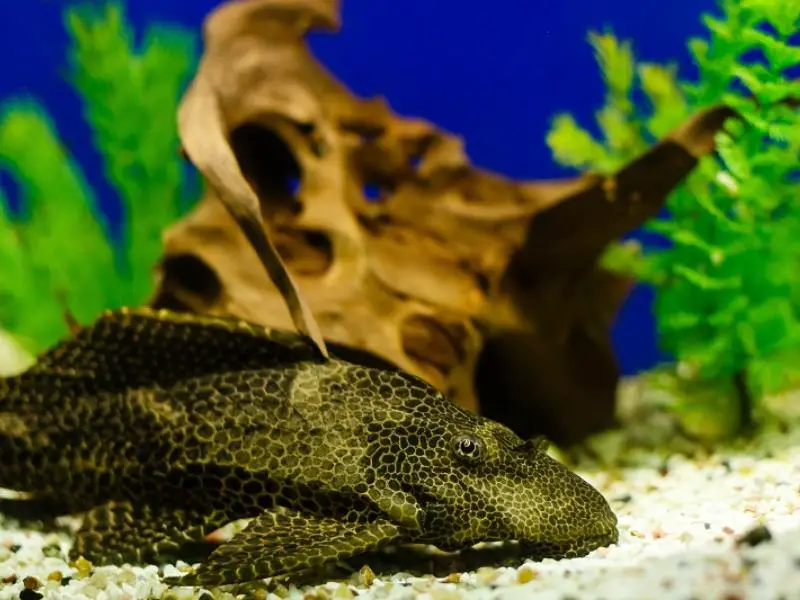
| Scientific name | Pterygoplichthys gibbiceps |
| Common name | Sailfin pleco, leopard pleco, high fin spotted plecostomus, spotted sailfin pleco, gibbiceps pleco, Columbian spotted pleco |
| Distribution | Brazil, Colombia, Ecuador, Peru, and Venezuela |
| Size | 15–20 inches |
| Life expectancy | 15–20 years |
| Color | Tan with black or dark brown spots |
| Diet | Omnivore |
| Temperament | Peaceful |
| Minimum tank size | At least 70 gallons per fish |
| Temperature | 73–79°F (25–26°C) |
| pH | 6.5–7.5 |
| Hardness | 9–20 dGH |
| Care level | Easy |
| Breeding | Egg-layer |
Origin
The sailfin pleco originates in regions in the north of South America, where the species is abundantly found.
The fish’s natural habitat is slow-flowing, murky waters spanning Brazil, Colombia, Ecuador, Peru, and Venezuela.
In the wild, sailfin plecos are known to group together to search for food. The fish stay near the bottoms of rivers and bury themselves in mud when the water levels fall too low.
Adult Size & Lifespan
The average adult size of a sailfin pleco is 15–20 inches. This large fish requires a big tank, so the species isn’t suitable for all aquarists.
Female sailfin plecos are typically 1–2 inches larger than males.
In the wild, sailfin plecos live for 15–20 years. With the right care and diet, the fish may live beyond 20 years in captivity.
Availability
The sailfin pleco is a commonly available catfish species that can be found in pet stores and online.
Online stores are most likely to sell this fish species, for the average price of $12–$20 per fish.
Popular stores selling sailfin plecos are:
- LiveAquaria
- Imperial Tropicals
- Aquaticarts (albino sailfin pleco)
Appearance & Behavior
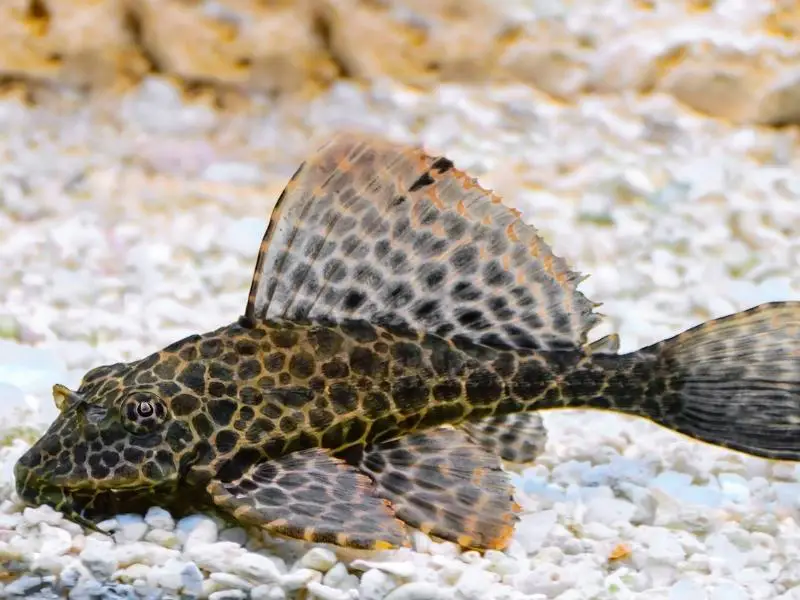
The sailfin pleco is a large fish with a tan body covered in dark brown or black spots. The fish is peaceful and low-maintenance, making it ideal for a community tank.
Colors, Patterns, Fins, and Sex Differences
Sailfin plecos have brown, orange, or tan bodies with a scattering of black, leopard-like spots from head to tail.
The fish have a similar appearance to other pleco species, with one exception: sailfin plecos have a tall, long dorsal fin with 12 or 13 rays that fan spectacularly behind the fish’s head, almost reaching the caudal peduncle.
Male sailfin plecos are typically slightly smaller than females and have a stump-like genital organ, while females have small genital papillae.
Females are rounder than males when viewed from the side, especially when gravid (pregnant).
When stressed, sailfin plecos are known to fade their colors. The fish may also lose their saturation with age.
Expect to see brighter-than-usual colors on your sailfin pleco when the fish is eating or breeding.
An albino variation of sailfin plecos also exists. These fish have white bodies with pink and yellow coloration and red eyes.
Typical Behavior
The sailfin pleco is a peaceful, quiet fish that makes a good addition to a peaceful community tank.
The fish alternates between active and inactive behavior throughout the day and is most active during the night.
Sailfin plecos spend most of their time slowly swimming around the bottom of the enclosure or sleeping in their favorite hiding spot.
These plecos get along well with other fish, but they’re known to display territorial behaviors to other fish of the same species, especially if tank space is limited or the fish are introduced to the tank at separate times.
If the sailfin pleco is underfed or housed in an overcrowded tank, it may exhibit aggressive behaviors like fighting. Ideally, don’t house multiple sailfin plecos together, to avoid conflict in the tank.
Sailfin Pleco Tank Requirements
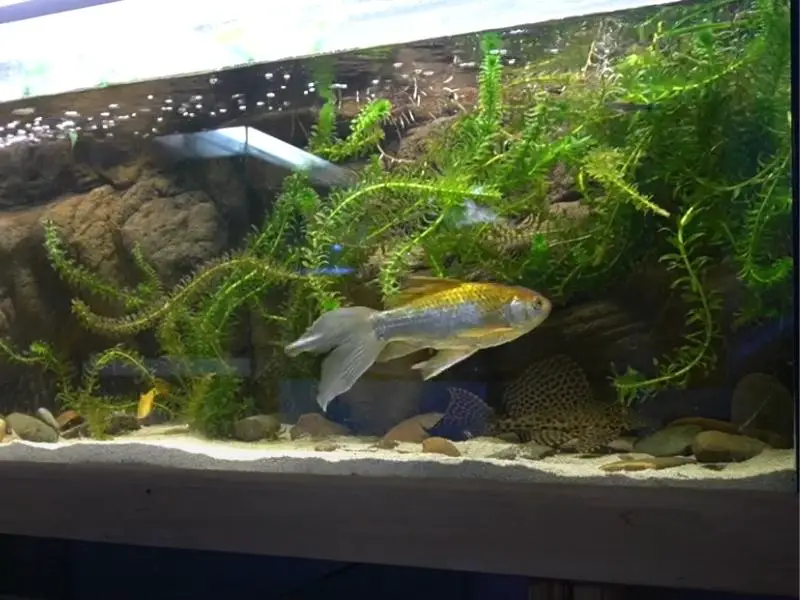
The sailfin pleco is easy to look after and has low care needs. The fish requires a clean tank, consistent water parameters, and an omnivorous diet to stay happy and healthy in captivity.
Habitat and Tank Setup
In the wild, sailfin plecos are found in slow-moving, murky freshwater rivers in Brazil and geographically similar regions.
That means the fish are adapted to warm waters with minimal movement. Aim to recreate this habitat in captivity.
To create a suitable tank setup for a sailfin pleco, buy an appropriately-sized tank (at least 70 gallons for one fish, ideally 100 gallons) and pour a 3-inch layer of the substrate into the bottom of the tank.
Sand is the best substrate because it’s soft and easy to burrow in, but sailfin plecos aren’t picky, so standard gravel is also fine.
For decorations, place at least one large piece of driftwood in the tank for the fish to hide beneath during the day.
The driftwood should also harbor algae growth, which the fish can feed off.
Caves are another good decoration choice, offering the fish additional hiding spots in the aquarium.
Live plants are great for creating a more natural environment in captivity.
Choose hardy plants that will grow back if they’re nibbled on by the fish, like water wisteria, hornwort, and java moss.
Tank Conditions
Ideal tank conditions for a sailfin pleco are:
- Water type: Hard, freshwater
- Tank size: Minimum 70 gallons, ideally 100 gallons
- Water temperature: 73–79°F
- Substrate: Sand or gravel
- Tank setup: Driftwood, caves, live plants
- Acidity: 6.5–7.5
- Water hardness: 9–20 dGH
- Filter: Yes, to keep the tank clean
- Bubbler: No, additional oxygen isn’t essential for sailfin plecos
Sailfin plecos are a fairly hardy species, but you should still maintain consistent water parameters and keep the tank clean to reduce stress and disease.
Common Sailfin Pleco Health Issues and Diseases
The sailfin pleco is a disease-resistant fish, but common freshwater health issues and diseases are still likely if this species is incorrectly cared for.
Some of the diseases known to affect sailfin plecos are listed in the table below.
| Health Issue | Symptoms | Suggested Action |
| ICH | White, salt-like spots on the body, flashing (rubbing) against rough objects, lethargy | Treat the entire aquarium with a commercial ICH treatment recommended by your veterinarian |
| Fin and tail rot | Ragged fins and tail, inflamed fins, white coloration, rotting of fins | Use antibiotics for jagged rotting or antifungal medications for evenly-spread rotting |
| Dropsy | Swelling of the abdomen, bulging eyes, loss of coloration in the fins | Correct the underlying problem (e.g. an unclean tank) and treat the fish with a broad-spectrum antibiotic |
Another health issue in sailfin plecos is starvation.
Some beginner aquarists (especially those who buy a pleco for tank-cleaning purposes) think that sailfin plecos can survive off eating algae alone, but that isn’t true.
Provide the fish with a varied diet to enjoy alongside the algae in your tank.
Sailfin Pleco Tank Mates
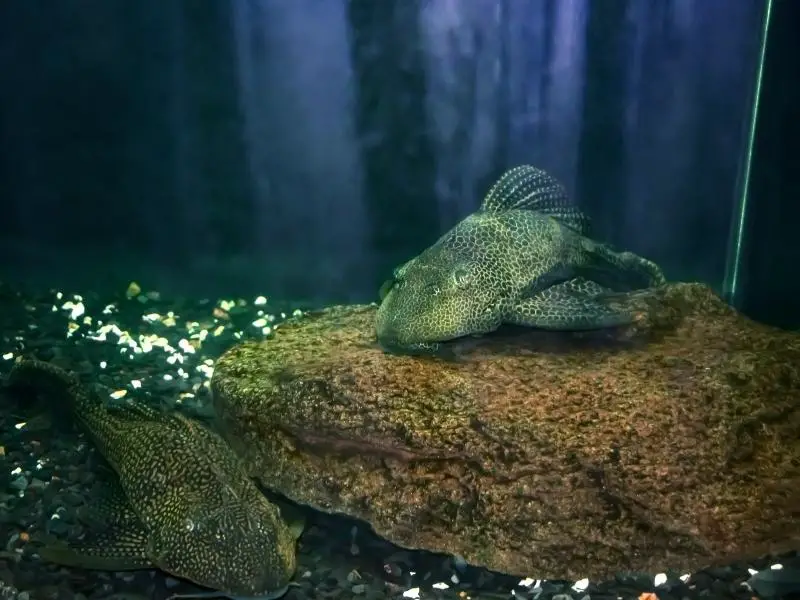
Sailfin plecos get along well with most other peaceful fish species of a similar size.
Good tank mates for sailfin plecos are slow-moving fish that occupy the upper regions of the tank and won’t invade the plecos’ space.
Great tank mates for sailfin plecos include:
- Some loach species (clown loaches, kuhli loaches)
- Some tetra species (bloodfin tetra, black skirt tetra)
- Some gourami species (honey gourami, sparkling gourami, pearl gourami)
- Silver dollar fish
Suitable non-fish tank mates for sailfin plecos are:
- Red cherry shrimp
- Freshwater crabs
Sailfin Pleco Diet and Feeding
Sailfin plecos are omnivores that aren’t picky with their food. In the wild, the fish eat plants, algae, and small insects.
Replicate this diet in captivity by providing a varied diet of plant-based foods and protein sources.
The best food choice for sailfin plecos is algae wafers. Don’t assume that your tank will contain enough natural algae to feed your pleco — it won’t.
Sailfin plecos are large fish and need enough food that they can eat within about two minutes.
Alongside algae wafers, vary your fish’s diet with veggies like cucumber and zucchini, and protein sources like freeze-dried or live bloodworms and larvae.
Feed your sailfin pleco twice per day. After the fish has eaten for two minutes, remove leftover food to prevent overfeeding, which leads to health complications like bloat.
Breeding the Sailfin Pleco
Sailfin plecos become sexually mature at about five years old when they’re about 3 inches long. In the wild, the fish breed when the water conditions become muddy.
Many of the fish dig tunnels in the mud during breeding.
There is little evidence of the successful breeding of sailfin plecos in captivity. This is because of the murky water conditions required for breeding.
Some commercial facilities are able to replicate these water conditions, but most hobbyist aquarists won’t have the space or setup required to attempt home breeding.
For this reason, breeding sailfin plecos in captivity aren’t advised.
Should You Get a Sailfin Pleco for Your Aquarium?
Sailfin plecos are unique, interesting fish that have beautiful markings.
You should consider getting a sailfin pleco if your tank has space for a large, bottom-dwelling fish, and you currently house peaceful fish in your aquarium.
Don’t get a sailfin pleco if your tank is small or already contains pleco species.
With its leopard-like coloring, low care needs, and useful algae feeding habits, the sailfin pleco is sure to bring a new entertaining personality to your tank.
FAQs:
How big does Sailfin Pleco get?
Sailfin plecos get up to 20 inches long (that’s about the size of a bowling pin). The average length of a sailfin pleco is 15–20 inches.
Wild sailfin plecos are likely to grow larger than captive fish, but fish housed in a large tank are still known to grow very big.
How many Sailfin Pleco should be kept together?
Ideally, only one sailfin pleco should be housed in a single aquarium. That’s because sailfin plecos are known to behave aggressively towards one another and fight over their territories.
If you do wish to house multiple sailfin plecos in the same tank, place a maximum of two sailfin plecos together in a minimum 140-gallon tank to avoid conflict.
What fish can live with Sailfin Pleco?
Fish that can live with sailfin plecos are clown loaches, kuhli loaches, bloodfin tetra, black skirt tetra, honey gourami, sparkling gourami, pearl gourami, and silver dollar fish.
The best fish to a house with sailfin plecos are similarly sized peaceful fish that occupy the top and middle sections of the tank.
Does Sailfin Pleco produce lots of waste?
Yes. Sailfin plecos are big fish with big appetites, and they produce a lot of waste as a result. Make sure to invest in a good filter to keep your aquarium water clean.

Be the first to comment